While many feel that email marketing is long dead and putting messages in your customers’ inboxes doesn’t really generate buzz, the truth is very different. Email marketing statistics show that this form of promoting one’s business is more successful than ever. It’s conversion-rich and can be used for anything from keeping your existing customers informed and happy, to reaching out to potential clients. While we’re not saying that you should neglect other marketing channels, email remains highly effective and is tried and tested many times over. Don’t believe us?! Read on to see that email marketing is alive and kicking.
Email Marketing Statistics (Editor’s Choice)
- By 2025, the number of email users around the world is expected to reach 4.594 billion. (Statista)
- Almost 80% of American employees check their work emails outside of working hours. (Statista)
- The best time to send marketing emails is 11 AM. (Get Response, Snovio Labs)
- 45.90% of emails are opened because of the sender’s name. (Super Office)
- Emails are the primary source for lead nurturing for 87% of B2B marketers. (CMI)
- A massive 81% of SMBs rely on email marketing to acquire customers. (CMI)
- For top-performing marketers, the average opt-in rate is 4.77%. (Finances Online)
Email Marketing Stats Rundown
1. By 2024, the number of email users around the world is expected to surpass 4.5 billion.
Data points to the growth of email as a communication medium. In 2017, there were 3.7 billion users of email around the world. The same study forecasts that, by 2024, this number will exceed 4.4 billion users globally.
(Statista)
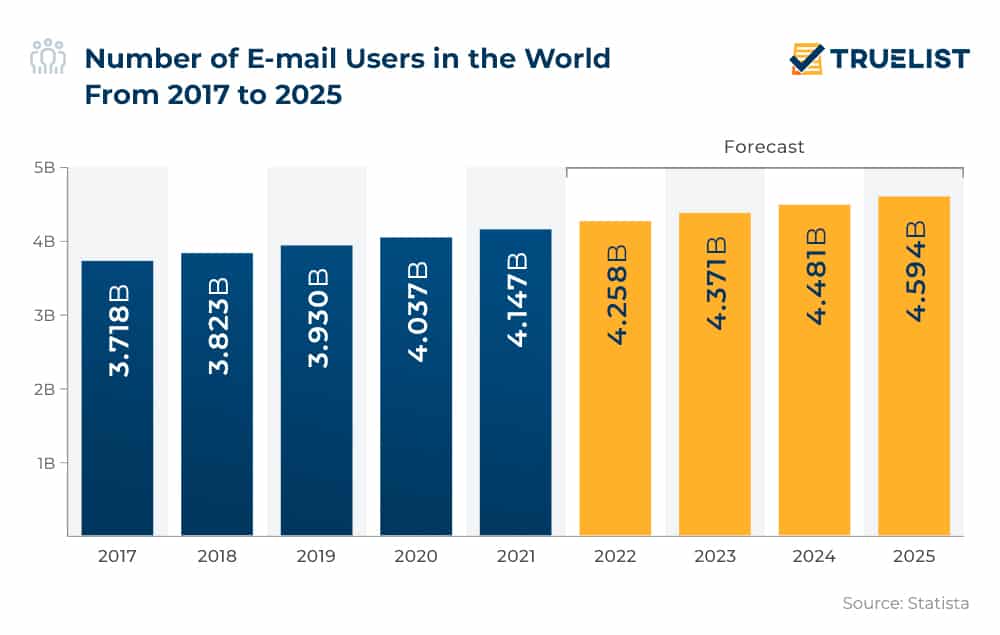
2. In the next four years, 58 billion junk emails will be sent.
Junk email statistics confirm that internet service providers are increasingly implementing better spam filters to keep customer inboxes clean of this ‘pest’. And while there has been improvement, nobody likes spam emails which is why marketers should start adapting to the way filters work to make sure their messages end up in the inbox as opposed to spam folders.
(Spam Laws)
3. Transactional emails comprise less than half of the 1.47 million emails US companies send on average per month.
Email marketing stats reveal that a total of 1.47 million emails are sent out by American companies on average every month. While transaction emails account for 41% of this number, marketing emails are actually more frequently sent in comparison – 59%. This just goes to show that US companies already know that email is here to stay and it’s rightfully called the backbone of modern marketing campaigns.
(Invesp)
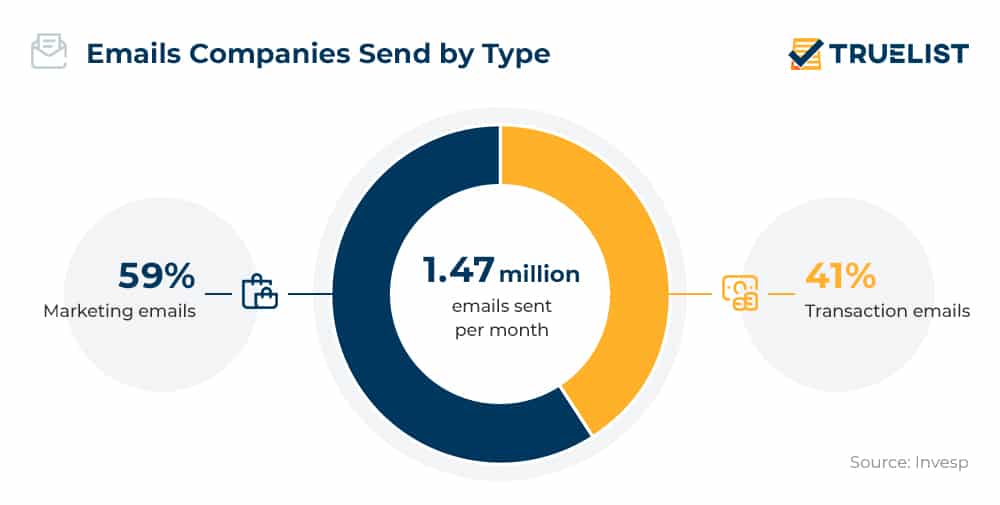
4. 86% of professionals prefer using email for business communication.
When it comes to purely business purposes, email usage statistics suggest that email is the preferred medium of choice for communication compared to other channels, which proves that email marketing companies can generate a lot of revenue. Email, favored by 86% of respondents, is followed by face-to-face communication with 60%. At 56%, phone calls come in at a close third, whereas social and video are the mediums of choice for 39% and 38%, respectively. Lastly, messaging is the least favorite way with only 31%.
(Lyfe Marketing)
5. Almost 80% of American employees check their work emails outside of working hours.
If your company has an ongoing webinar or tradeshow campaign, emails are a good way to promote them. Statistics on email marketing confirm 43% of workers check their emails outside of normal working hours. Another 13% check their emails a few times within the hour, and 11% check their inboxes every hour. This could be related to the increase in mobile opens but interestingly, 10% of employees are constantly expecting a new email to reach them. This data is important for marketers as it shows customers are willing to read emails even if they don’t receive them during working hours.
(Statista)
6. The best time to send marketing emails is 11 AM.
The latest email marketing effectiveness statistics show that the traffic peak happens in autumn and winter, especially for events such as Black Friday, Cyber Monday, and the day before Christmas Eve, December 23rd. Aside from those and if it’s not the holiday season, the best days to send emails are Tuesdays and Thursdays at around 11 AM. If your goal is to boost your email click-through rate, studies show that emails sent at 12 AM generate the highest CTR.
(Get Response, Snovio Labs)
7. 45.90% of emails are opened because of the sender’s name.
Email marketing statistics show that almost half of the emails are opened because of the sender’s name. Users prefer to open emails sent by a person instead of a company, and as stats further show, using a personal name can increase the average email open rate by as much as 35%. Using a catchy subject line also works wonders, with data pointing to it as the second most common reason for email opens with nearly 34%.
(Super Office)
8. 58% of adults check their email as soon as they wake up.
Another thing we know, courtesy of email marketing statistics and metrics, is that the first thing 58% of adults are likely to do when they wake up in the morning is to check their email. Just imagine: a potential customer wakes up and the first email in their inbox is one from you, notifying them that you’re offering a discount on your products. Unfortunately, many customers don’t know what flagging an email does, and it can be a very useful reminder.
(WebFX)
9. Mobile devices account for 53% of all opened emails, and those same emails are opened again later by 23% of recipients.
Mobile email statistics and facts say smartphones and other mobile devices have a lot to do with the success rates of email marketing campaigns. Email marketing statistics show that more than one-half of emails sent out by marketers are accessed on mobile devices, most likely due to the convenience they provide, such as ease of access and mobility. At the same time, these same emails are reopened later by 23% of recipients, once again confirming that there’s just no substitute for a well-crafted and precisely targeted email campaign.
(WPForms)
10. Webmail clients are used for opening 40% of all emails received.
People most commonly use webmail clients to access their received emails (40%). Email usage statistics reveal that, among this percentage, the biggest share on the market belongs to Gmail (26.2%). The second and third places go to Yahoo! Mail (6.6%) and Outlook.com (2.4%), respectively.
(Finances Online)
11. Emails make the buying process 3X faster compared to social media.
A recent study revealed that, compared to social media, the buying process is three times faster when taking place through email. Email marketing facts presented in the same study also put the effectiveness of emails 40 times higher than that of social media. Simultaneously and across all industries, emails have an open engagement rate of 22.68%. For the sake of comparison, the combined overall engagement of Instagram, Twitter, and Facebook is 0.58%.
(Monster Insights)
12. For every dollar spent on email marketing, the expected return is $42.
There is absolutely no reason why you shouldn’t expect a solid email marketing ROI if you build a well-thought-through strategy. Email marketing ROI statistics indicate that if a marketer spends one dollar on email marketing, they can expect an average return of up to $42. This data shows that there are not only multiple benefits to email marketing but also excellent returns that will help you keep your business steady and going.
(Oberlo)
13. Emails have the best return on investment for 59% of marketers.
Emails are not just one of the oldest digital marketing tools for attracting the attention of potential customers, but as email marketing facts show, almost six out of ten marketers consider them as the best way to see ROI. In fact, for a whopping 89% of marketers, emails are the main and most effective channel for generating leads. Then, when it comes to evaluating and analyzing data, emails are the number one most reliable source for marketers.
(Campaign Monitor)
14. Segmented campaigns yield an increase in revenue as high as 760%.
There’s a clever hack you can use to maximize the revenue from your marketing campaigns and statistics on email marketing show the way; instead of sending out a bulk email to all of the clients on your mailing list, put in just a bit more effort to generate segmented campaigns and divide your mailing list according to various criteria. This approach, discussed in a recent report by Campaign Monitor, takes just a bit longer to implement but generates a whopping 760% rise in revenue.
(Campaign Monitor)
15. A significant 40% of marketers do not send targeted emails to clients.
Email marketing success rates tend to plummet unless marketers send targeted emails to clients. Statistics about email marketing originating from a recent study indicate that 40% of marketers cannot ignore this huge opportunity to capitalize on their campaigns. And as noted above, email list segmentation can result in much higher revenue than usual, and the process starts by prioritizing your clients’ identity. Generic emails just won’t do here; hyper-targeted emails are the way to go to make your email marketing campaigns more relevant.
(Lyfe Marketing)
16. Email marketing is used by a staggering 97% of businesses to convert prospects into buyers.
Recent email marketing stats reveal that the majority of businesses rely on this type of marketing to boost their conversion rates. Why? 97% of digital marketing agencies are well aware that 76% of subscribers decide to make a purchase just because they saw and read the email marketing message sent to them.
(Disruptive Advertising)
17. The primary goal of 67% of email marketers is to boost engagement.
Boosting engagement, according to email marketing statistics and metrics, is the biggest obstacle to overcome for nearly half of email marketers worldwide, though slightly more of these professionals (67%) also see this as the initial goal of their campaigns. Other objectives include improving brand awareness for 59% of marketers, increasing lead generation (47%), boosting conversions (39%), increasing their list growth (20%), improving personalization (19%), and improving data list quality (16%).
(Business 2 Community)
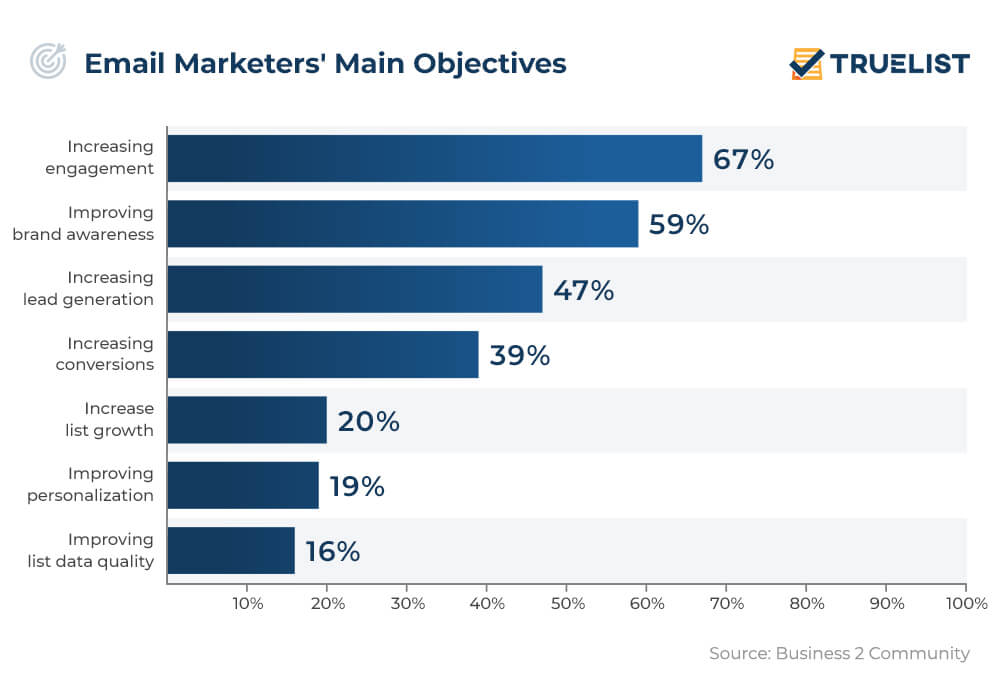
18.16.4% of marketers struggle with poor coordination between other departments and channels.
Email marketing, as rewarding as it may be, is still a major challenge for marketers as they fail to provide enough evidence to make the case for it. Stats on email marketing show 16.4% of marketers are frustrated by poor coordination between departments, 14.4% are understaffed, 14.1% face limitations from their email service provider, and another 12.8% complain about the quality of their strategy and leadership team. Lack of quality data, inadequate tools for creating good emails, and low visibility into email performance and deliverability are a constant struggle for professionals who understand the true value of email marketing.
(Litmus)
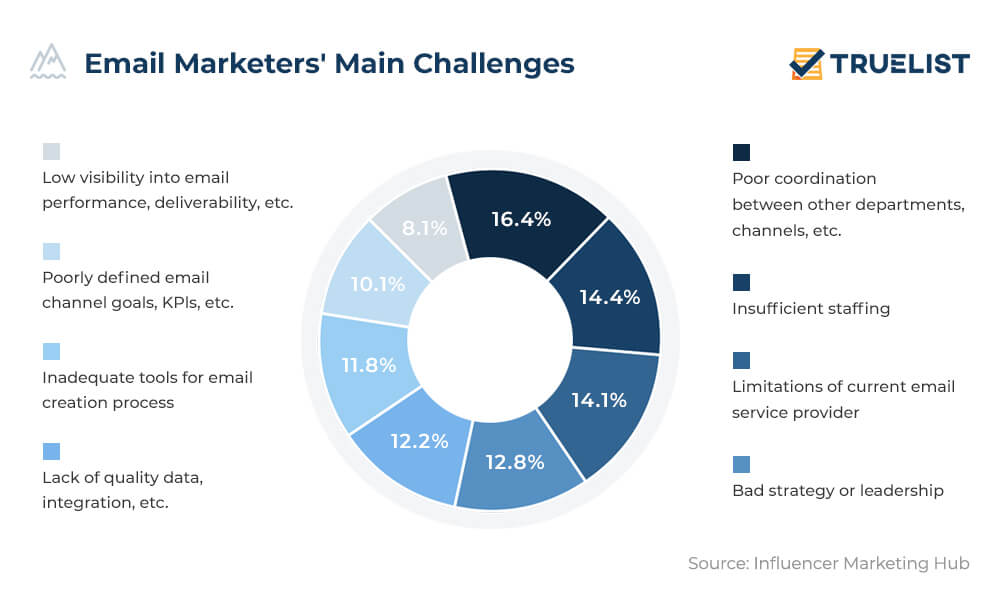
19. A massive 81% of SMBs rely on email marketing to acquire customers.
Statistics about email marketing and the extent to which small and midsize businesses benefit from it reveal some astonishing data. For a total of 81% of SMBs, email marketing is still the primary channel for acquiring customers, and for 80%, according to small business stats, it is also the main source for retaining customers.
(Oberlo)
20. Having only five email campaigns a month results in the highest open rate (44%).
With digital technologies, it’s incredibly easy to fall into the “more is more” trap, especially so during an email campaign. But, this is the ideal example of a situation where the opposite is true: emailing statistics show that less is more for sending out emails either to existing or potential customers. Research shows that five email campaigns per month lead to the highest open rates. Not stuffing your client’s inbox with promotional emails, therefore, has proven to be effective.
(Backlinko)
21. Emails are the primary source for lead nurturing for 87% of B2B marketers.
Almost 90% of marketers in North America rely on emails as the most efficient way to nurture leads. B2B email marketing statistics also confirm that partner emails are an excellent way to promote content for 51% of top B2B marketers. The same research found that 93% of B2B marketers operating in North America distribute content via emails, and this is a technique used by both top successful and not-so-successful marketers.
(CMI)
22. The average benchmark for email open rates stands at 21.5%.
The average email marketing benchmarks by industry for open rates are highest for education at 28.5%, agriculture at 27.3% and nonprofit at 26.6%, as email marketing statistics reveal. To give you a clearer image of these figures consider this: the average email open rate is 21.5%, the click to open rate is 10.5%, and the email click-through rate is 2.3%.
(Campaign Monitor)
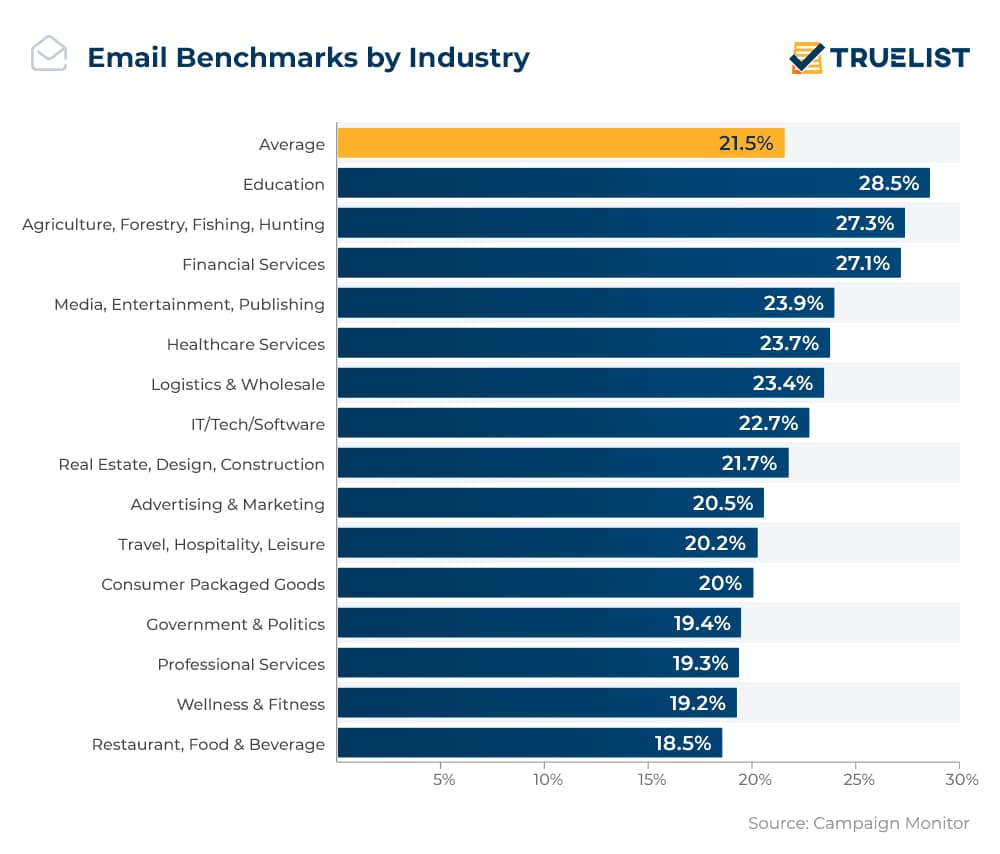
23. Newsletters as part of content marketing are used by 81% of B2B companies.
Newsletters are used across industries as a way to spread the latest updates about ongoing business activities, but they are also an effective technique for boosting content marketing. According to B2B email marketing statistics, for an impressive 81% of B2B marketers, newsletters are an integral part of their marketing program. Moreover, for 31% of B2B marketers, newsletters are not only part of the content marketing strategy but are critical to its success and the best lead nurturing tool.
(CMI)
24. For 10% of the top-performing marketers, the average opt-in rate is 4.77%.
One of the metrics used to evaluate the success of an email marketing strategy is the opt-in rate or the percentage of site visitors who subscribe to your email list. Opt-in email marketing statistics indicate that the average email opt-in rate is 1.95% across all verticals. What this means is that of the 10 visitors visiting your website, only about 2 will subscribe to your emails. For the top 10% of email marketers, however, the average opt-in rate is much higher and stands at 4.77%.
(Finances Online)
25. 59% of email subscribers unsubscribe because they receive too many emails.
A stellar email marketing strategy is not just about getting subscribers but also about keeping them. The latest stats on email marketing present the three most common reasons why people unsubscribe from an email list, and the top one cited by 59% of (un)subscribers is “I am getting too many emails”. 43% say they’ve unsubscribed because they are receiving irrelevant information or do not recognize the brand.
(Optinmonster)
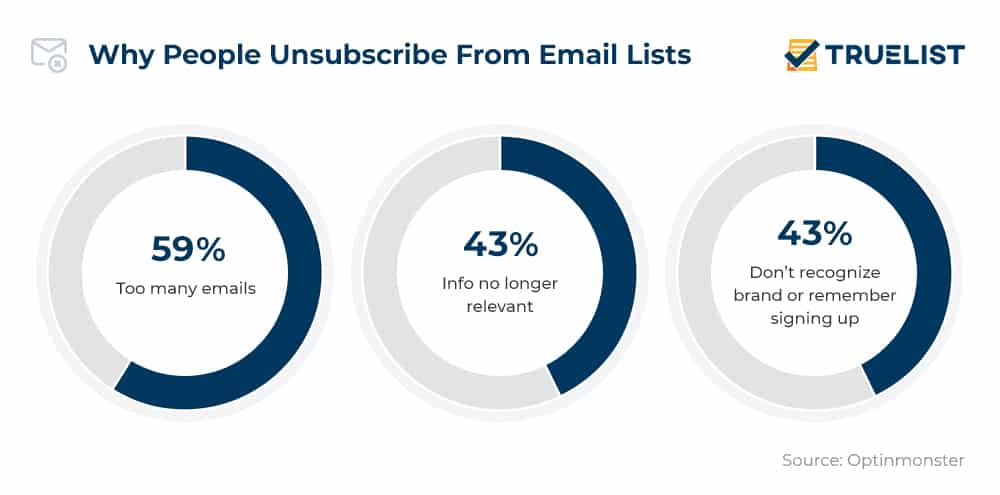
26. Automation is used to send 47% of welcome emails.
Automation tools are introducing the new rules of email marketing and email marketing automation statistics prove that it is used by all marketers for all types of emails. A solid 46% of promotional emails are sent via automation tools, 28% of transactional emails, 27% of invitations and reminders, and 26% of blog updates. Automation is also used to send 23% of upselling emails and 15% of event-triggered emails based on the customer lifecycle.
(Snovio Labs)
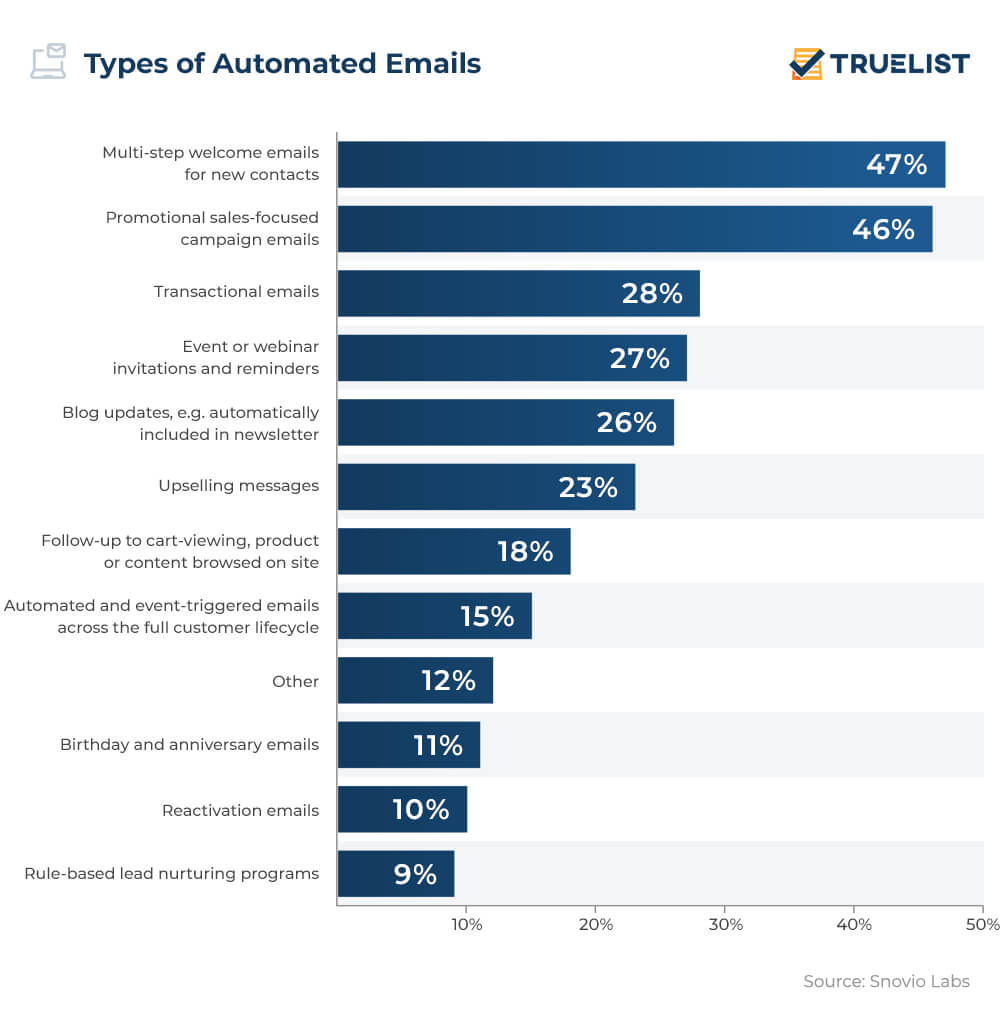
27. Email automation is the number one factor used by 66% of marketers to improve email effectiveness.
The most recent email marketing effectiveness statistics point to automation as the most widely used technique by a total of 66% of marketers in an attempt to improve the effectiveness of their marketing efforts. Going forward, one-third of marketers (37%) say they will be focusing on automated email campaigns, 32% believe personalization holds the key to a winning marketing strategy, while 29% believe email segmentation is the best option to acquire and engage more customers.
(Influencer Marketing Hub)
Wrapping it Up
While new forms of communication and marketing channels have taken the world by storm, the good old email has managed to hold its own. Moreover, automation will be steering the wheel of the future of email marketing and ensure campaigns become more hyper-targeted and effective. And as these email marketing statistics conclusively show, its easy personalization and higher customer interaction properties have only made it more resilient in the age of social media and short attention spans.
Sources: Statista, Spam Laws, Invesp, Lyfe Marketing, Statista, Get Response, Snovio Labs, Super Office, WebFX, WPForms, Finances Online, Monster Insights, Oberlo, Campaign Monitor, Campaign Monitor, Disruptive Advertising, Business 2 Community, Litmus, Backlinko, CMI, Campaign Monitor, CMI, Optinmonster, Influencer Marketing Hub

